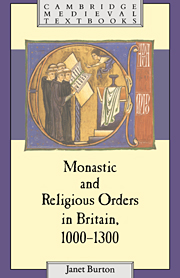Book contents
- Frontmatter
- Contents
- List of illustrations
- Preface
- 1 Before the Normans
- 2 The coming of the Normans
- 3 The regular canons
- 4 The new monastic orders of the twelfth century
- 5 Women and the religious life
- 6 The mendicant orders
- 7 The physical setting: monastic buildings and the monastic plan
- 8 Inside a religious house: daily life and the chain of command
- 9 Learning and literary activities
- 10 Religious houses and the wider community: founders, patrons and benefactors
- 11 The monastic economy
- 12 On the brink of change
- Glossary
- Notes
- Select bibliography
- Index
- Cambridge Medieval Textbooks
2 - The coming of the Normans
Published online by Cambridge University Press: 05 June 2012
- Frontmatter
- Contents
- List of illustrations
- Preface
- 1 Before the Normans
- 2 The coming of the Normans
- 3 The regular canons
- 4 The new monastic orders of the twelfth century
- 5 Women and the religious life
- 6 The mendicant orders
- 7 The physical setting: monastic buildings and the monastic plan
- 8 Inside a religious house: daily life and the chain of command
- 9 Learning and literary activities
- 10 Religious houses and the wider community: founders, patrons and benefactors
- 11 The monastic economy
- 12 On the brink of change
- Glossary
- Notes
- Select bibliography
- Index
- Cambridge Medieval Textbooks
Summary
The Norman invasion and conquest of England had a self-consciously ecclesiastical dimension. Norman writers who sought to legitimize William's actions stressed that King Harold, who had had himself crowned the day after the Confessor's funeral, was a perjurer: that during a visit to Normandy he had promised on sacred relics to support the claim of Duke William, and the fact that he had broken that oath meant that he was unfit to be king. The accuracy of Norman propaganda need not concern us here, for what is of more immediate significance is that the Conqueror gained the support of the church for his invasion. Norman churches helped to finance the expedition, and the pope gave it his sanction, thus enabling William to fight under a papal banner promising not only to depose the perjurer, but also to reform the English church. How far the Anglo-Saxon church was in need of serious or thorough reform is open to question. Certainly its reputation then, as since, has been dominated by the bias of the historical sources as well as the existence of the notorious pluralist Stigand, archbishop of Canterbury and concurrently bishop of Winchester. As the previous chapter has argued, there is no evidence of serious moral decay or need for reform among the Old English monasteries.
THE ANGLO-SAXON HOUSES
What did William know about the religious houses of the land he was about to govern? Norman infiltration into the ranks of the upper clergy had begun before the death of the Confessor.
- Type
- Chapter
- Information
- Monastic and Religious Orders in Britain, 1000–1300 , pp. 21 - 42Publisher: Cambridge University PressPrint publication year: 1994

